
…and if you do this with a raincoat, you can eat cereal.
This article also appears in The Adventures of Accordion Guy in the 21st Century.

…and if you do this with a raincoat, you can eat cereal.
This article also appears in The Adventures of Accordion Guy in the 21st Century.

Even though I’m no longer a Developer Evangelist with Microsoft anymore, the dead-ending of their XNA games development toolset upsets me. This development was quietly announced to XNA MVPs (Most Valued Professional – an officially recognized “civilian evangelist” for a Microsoft technology or tool, a title which comes with a fair number of perks) in their mailing list. Until MVP Promit Roy shared the following snippet of the email on his blog, it was generally unknown:
The XNA/DirectX expertise was created to recognize community leaders who focused on XNA Game Studio and/or DirectX development. Presently the XNA Game Studio is not in active development and DirectX is no longer evolving as a technology. Given the status within each technology, further value and engagement cannot be offered to the MVP community. As a result, effective April 1, 2014 XNA/DirectX will be fully retired from the MVP Award Program.
You could think of XNA as a thin wrapper around a bunch of DirectX’s components, but I preferred to think of it as a way to make game development simple and deployable to a number of Microsoft platforms: Windows, Windows Phone and Xbox 360 (and if you have a soft spot for stillborn platforms, Zune). I loved XNA because it made the hard stuff easier and the seemingly impossible possible; it also allowed an eager game developer go, as I liked to put it, “from zero to awesome in sixty minutes”. I myself ran a series of game development tutorials for university students in eight cities across Canada during TechDays 2010, where I gave them a forty-minute crash course in native mobile game development:
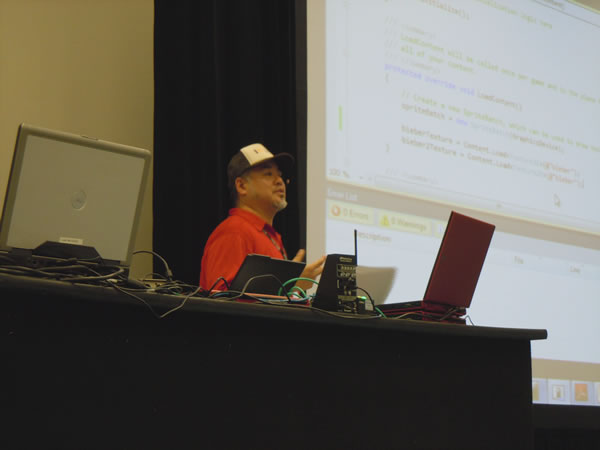
Me teaching XNA development for Windows Phone in Vancouver, September 2010.
If you look closely, you can see variables named bieberTexture and bieber2Texture.
Best of all, I did it from scratch: by live-coding up a simple game, from File -> New to playable demo, right in front of their eyes. In my allotted forty minutes, I walked them through the basics of sprite textures, moving them about the screen, collision detection, playing sounds and, since I was talking about XNA game development for Windows Phone, touch detection. We started with simple variable declarations and finished with an amusing game called Biebersmash (named after Scott Hanselman’s game, BabySmash), a Bieber-flavoured “punch the monkey” game.
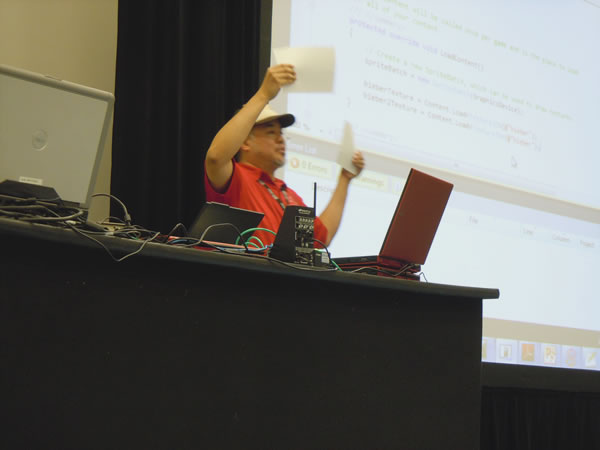
Demonstrating how simple rect-based collision detection works with two sheets of paper.
I’ve seen some great 2D and 3D XNA-based Windows Phone apps built by local developers, and I worked hard to make sure that they got noticed by both the game-buying public as well as The Powers That Be within Microsoft. Of note was Mike Kasprzak’s incredibly addictive Smiles, pictured below:

Here’s a little Smiles gameplay:
Also of note was Sudoku 3D by Alexey Adamsky and Alex Yakobovitch, which used XNA’s 3D mode to present the gamer with a maddeningly frustrating yet addictive twist on Sudoku:

And XNA was a big part of the game design and development courses at the University of Toronto, some of which were taught by my friend Steve Engels, who’s featured in this video:
When XNA’s aggressive update schedule — five major updates in under two years — suddenly stopped with XNA 4.0 in the fall of 2011, it was cause for concern. Some people saw the writing on the wall a little earlier than others, and given Microsoft’s history of hyping certain technologies and giving them lots of love and attention in the beginning and then letting them die from neglect, their arguments were credible.
Still, many developers held onto the hope that the technology that they loved and that had enriched their lives would go on. It’s a rare thing when developers get emotionally attached to a toolkit, but developers did get emotionally attached to XNA. While it doesn’t have the fanbase of something like Rails, there was enough of a Twitter groundswell. Seriously, check out the tweets with the hashtag #BecauseOfXNA:
#becauseofxna I moved from MI to WA, got paid to write Zune HD games, worked at MS for 2.5 years, and currently contract with Turn 10.
— Nick Gravelyn (@nickgravelyn) January 31, 2013
#becauseofXNA – I am a published author and got to travel to Seattle and meet dozens of awesome developers and MS personnel
— Jim Perry (@MachXGames) January 31, 2013
#becauseofxna I released games, ran business, did blog/mag/radio interviews, spoke at conferences & worked in games for my childhood heroes.
— Deejay (@BinaryTweedDeej) January 31, 2013
#BecauseofXNAI’ve gone to Germany, became an MVP, spoke at GDC, helped sell thousands of titles through an indie promo, made a game…
— Dave Voyles (@DaveVoyles) January 31, 2013
#becauseofXNA I could afford to fly my family to visit my father before he passed away
— Bill Fowler (@dadooGames) January 31, 2013
#BecauseofXNA I was able to start a small game company and peruse being and Indie Game developer as a full time endeavor.
— DigitalDNA (@DigitalDNAGames) January 31, 2013
#becauseofxna FEZ happened, and I realized that I wanted to do games programming for a living, and am doing it right now!
— Renaud Bédard (@renaudbedard) January 31, 2013
#becauseofxna I’m not stuck working for someone else. Also, you know, a million sales is nice. :-)
— DjArcas (@Fortress_Craft) January 31, 2013
#becauseofxna my childhood dream came true. Just wish I could show the kid version of me the game I made with this technology.
— Chaosoft Games (@ChaosoftGames) February 1, 2013
#BecauseofXNA Hating C++ and being a game developer is not mutually exclusive
— Nick Landry (@ActiveNick) February 1, 2013
I met my wife #becauseofxna! I love you, @shelldragon :)
— James Silva (@Jamezila) February 1, 2013
#becauseofxna we, as a small game development studio, were able to create our first console game! #rocketriot
— Codeglue (@Codeglue) February 4, 2013
It breaks my heart to see the hopes of these developers’ hopes dashed.
Microsoft’s official stance is that XNA remains a supported technology, but speaking as a former insider, I would take that with a softball-sized grain of salt. It simply means that it works on the current platforms, and no more. If you’ve got an XNA project with a user base, you can continue for a little bit. However, if you’re thinking of starting something new, take XNA off the list of possible tools. While platforms and toolsets never quite truly die, they often become undead, and that’s no good to you.
DirectX, it would seem despite the confusing messaging from Microsoft, is an ongoing concern (but don’t believe them completely). That’s cold comfort to the developers who built their games and careers on XNA; while DirectX is the underlying technology, it’s the XNA wrapper that brought them in.
 It’s yet another Microsoft technology that entered with much fanfare, followed by much fandom, then left to die like a forgotten dog in a car on a hot August day. It’s another sign of the rot deep within The Empire, and some very big problems with which their (mis)management has to contend. While I have much to say on that topic, I’ll leave the final word to Promit Roy, who sums up my opinion on whether or not you should bet on the Microsoft platform:
It’s yet another Microsoft technology that entered with much fanfare, followed by much fandom, then left to die like a forgotten dog in a car on a hot August day. It’s another sign of the rot deep within The Empire, and some very big problems with which their (mis)management has to contend. While I have much to say on that topic, I’ll leave the final word to Promit Roy, who sums up my opinion on whether or not you should bet on the Microsoft platform:
Just to be clear, I don’t attribute any of this fumbling to malice or bad faith. There’s a lot of evidence that this type of behavior is merely a delayed reflection of internal forces at Microsoft which are wreaking havoc on the company’s ability to compete in any space. But the simple ground truth is that we’re entering an era where Windows’ domination is openly in question, and a lot of us have the flexibility and inclination to choose between a range of platforms, whether those platforms are personal computers, game consoles, or mobile devices. Microsoft’s offer in that world is lock-in to Windows, in exchange for powerful integrated platforms like .NET which are far more capable than their competitors (eg Java, which is just pathetic). That was an excellent trade-off for many years.
Looking back now, though? The Windows tech hegemony is a graveyard. XNA. Silverlight. WPF. DirectX. Managed C++. C++/CLI. Managed DirectX. Visual Basic. So when you guys come knocking and ask us to commit to Metro — sorry, the Windows 8 User Experience — and its associated tech?
You’ll understand if I am not in a hurry to start coding for your newest framework.
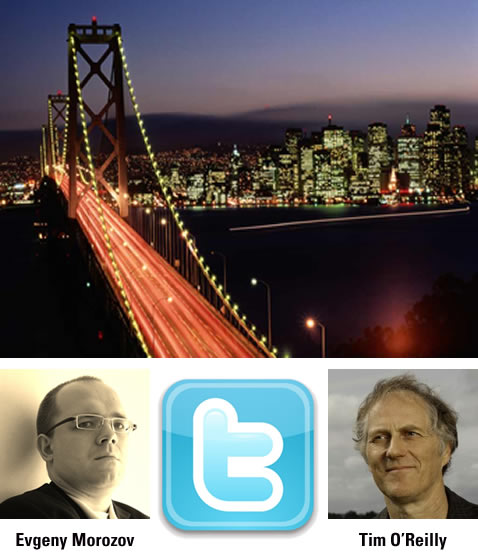
There’s an interesting debate that’s beginning to brew on Twitter between:
The debate began with this tweet:
Rebecca Solnit’s essay on how Slicon Valley is draining San Franscisco of its dissident spirit is so good lrb.co.uk/v35/n03/rebecc…
— Evgeny Morozov (@evgenymorozov) January 31, 2013
The essay in question is a diary entry by San Francisco-based writer Rebecca Solnit, author of Infinite City: A San Francisco Atlas, an exploration of the city through many different points of view. The entry appears in the February 7, 2013 edition of the London Review of Books (and online here), and it looks at the detrimental effect of the culture of Silicon Valley on San Francisco. She writes that like the prospectors from the Gold Rush, who came to the area to get rich and whose wealth allowed them to take over the place, the techies who come to the Bay Area today are displacing those who have called the place home for decades:
A Latino who has been an important cultural figure for forty years is being evicted while his wife undergoes chemotherapy. One of San Francisco’s most distinguished poets, a recent candidate for the city’s poet laureate, is being evicted after 35 years in his apartment and his whole adult life here: whether he will claw his way onto a much humbler perch or be exiled to another town remains to be seen, as does the fate of a city that poets can’t afford. His building, full of renters for most or all of the past century, including a notable documentary filmmaker, will be turned into flats for sale. A few miles away, friends of friends were evicted after twenty years in their home by two Google attorneys, a gay couple who moved into two separate units in order to maximise their owner-move-in rights. Rental prices rose between 10 and 135 per cent over the past year in San Francisco’s various neighbourhoods, though thanks to rent control a lot of San Franciscans were paying far below market rates even before the boom – which makes adjusting to the new market rate even harder. Two much-loved used bookstores are also being evicted by landlords looking for more money; 16 restaurants opened last year in their vicinity. On the waterfront, Larry Ellison, the owner of Oracle and the world’s sixth richest man, has been allowed to take control of three city piers for 75 years in return for fixing them up in time for the 2013 America’s Cup; he will evict dozens of small waterfront businesses as part of the deal.
Here’s an excerpt from its final paragraph:
I think of it as frontierism, with all the frontier’s attitude and operational style, where people without a lot of attachments come and do things without a lot of concern for their impact, where money moves around pretty casually, and people are ground underfoot equally casually. Sometimes the Google Bus just seems like one face of Janus-headed capitalism; it contains the people too valuable even to use public transport or drive themselves. In the same spaces wander homeless people undeserving of private space, or the minimum comfort and security; right by the Google bus stop on Cesar Chavez Street immigrant men from Latin America stand waiting for employers in the building trade to scoop them up, or to be arrested and deported by the government. Both sides of the divide are bleak, and the middle way is hard to find.
It reminds me of Paulina Borsook’s Cyberselfish: A Critical Romp through the Terribly Libertarian Culture of High Tech, published back in 2001, as well as her 1999 essay, How the Internet Ruined San Francisco, which I read prior to moving there to contribute to the ruination.
Strangely enough, there’s no Wikipedia entry for Paulina Borsook, even though she’s notable enough to warrant her own page. Perhaps the Wikipedians (a rather huffy libertarian bunch, from the sound of them) aren’t too keen on her. I’m not the only one who’s noticed this recently.
In response to Morozov’s initial tweet, Tim O’Reilly posted this:
@evgenymorozov Yes, but is it true? It seems very selective to me, as is often the case with writing that draws power from being “against”
— Tim O’Reilly (@timoreilly) January 31, 2013
…and thus began the debate:
@timoreilly oh yes, I’m sure that writing about “open source” and “web 2.0” and “govt 2.0” has never been “selective” or “against”
— Evgeny Morozov (@evgenymorozov) January 31, 2013
@evgenymorozov …attempting to build up your own reputation by tearing someone else’s down. I like positive visions.
— Tim O’Reilly (@timoreilly) January 31, 2013
@timoreilly I seriously doubt that Rebecca Solnit needs to “build up her reputation” – I’m afraid she’s not in the business of meme-hustling
— Evgeny Morozov (@evgenymorozov) January 31, 2013
@evgenymorozov I’ve been disappointed by your willingness to attack me without ever being willing to talk. I’m a convenient straw man.
— Tim O’Reilly (@timoreilly) January 31, 2013
@timoreilly I know all your memes by heart – there is no need to talk. Alas, I don’t talk to PR people, even if they are worth millions.
— Evgeny Morozov (@evgenymorozov) January 31, 2013
@evgenymorozov Your unwillingness to engage brands you an opportunist, who builds his name by trashing others, not caring about truth
— Tim O’Reilly (@timoreilly) January 31, 2013
@timoreilly want me to engage? I will engage, fine. It is on.
— Evgeny Morozov (@evgenymorozov) January 31, 2013
While I understand and even sympathize with Morozov’s point of view — I’ve seen what he and Solnit are talking about first-hand — he comes off as being a bit of a dick. Perhaps it’s my bias: I know Tim O’Reilly, and the last time I saw him (at SxSW 2012), he stood up from the middle of his conversation, yelled “Joey!” and gave me a big hug.
As much as I like watching a good heated exchange, I’m with Jeff Sonstein, who tweeted this comment in the middle of the back-and-forth between Morozov and O’Reilly:
@evgenymorozov if you 2 don’t get involved in a flame-war, IMHO you could spark some excellent & useful discussions /cc @timoreilly
— Jeff Sonstein (@jeffsonstein) January 31, 2013
They would be useful discussions, and not just in terms of the relationship of Silicon Valley and San Francisco. They’d be applicable to any city undergoing a transformation due to changes in the economy, or an influx of new people, or even just plain old gentrification. Do newcomers to a city have responsibilities ensure that their disruption is minimal to those who already live there? Are the private systems like the Google Bus, which hauls Google employees to work, merely a practical way to let employees enjoy city life at home and still work in Mountain View, deep in the exurbs, or is it a snobbish way of shielding the tech aristocracy from the local hoi polloi? Does the “I’m building the future” mindset blind us to our actions, letting us carelessly destroy the past?
As techies, these are questions we have to at least consider, if not answer.
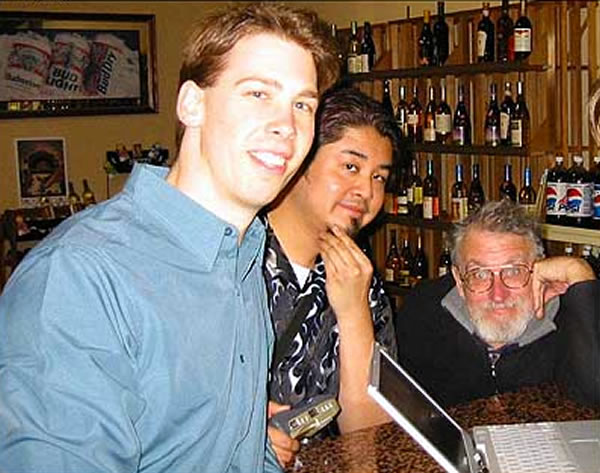
Beware the powerful stare of Captain Crunch. You know what I’m talking about…
 There’s a lot going on today for me: I’m getting some much-needed plumbing repairs done, putting together a proposal for a big consulting gig, moving into a new office and trying to launch a coworking space. Understandably, I had a little trouble getting to sleep, so I decided to be productive and update the hell out of my LinkedIn profile. If you check it out now, you’ll see that it now includes a lot of media links, including an article from Der Spiegel about Peekabooty, the censor-busting proxy application that Paul Baranowski built and for which I programmed and designed the UI (also the last time I did any coding in C++). I can’t read German, so for me, the article is most notable for one of its photos (shown above) featuring Paul, me and a wild-eyed John “Captain Crunch” Draper taking a break from CodeCon 2002 in San Francisco.
There’s a lot going on today for me: I’m getting some much-needed plumbing repairs done, putting together a proposal for a big consulting gig, moving into a new office and trying to launch a coworking space. Understandably, I had a little trouble getting to sleep, so I decided to be productive and update the hell out of my LinkedIn profile. If you check it out now, you’ll see that it now includes a lot of media links, including an article from Der Spiegel about Peekabooty, the censor-busting proxy application that Paul Baranowski built and for which I programmed and designed the UI (also the last time I did any coding in C++). I can’t read German, so for me, the article is most notable for one of its photos (shown above) featuring Paul, me and a wild-eyed John “Captain Crunch” Draper taking a break from CodeCon 2002 in San Francisco.
Also featured in my LinkedIn profile: Developer Jr., in which my fantasy to host a Sesame Street-style show for kids came true…
…this hastily-put together clip in which I talk about HTML5 and rich internet applications (which Microsoft may have disavowed)…
…and that time when my fantasy to play the opening number for a big keynote at a developer conference came true…
It would appear that LinkedIn approves of the changes, judging by it’s “Profile Strength” gauge:
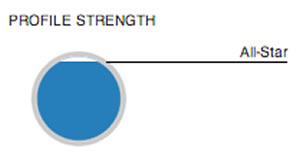
If you’re bored, go ahead and check out my LinkedIn profile. If you’re feeling inspired, go ahead and update yours!
This article also appears in The Adventures of Accordion Guy in the 21st Century.
 What, yet another mobile OS?
What, yet another mobile OS?
Well, yes, but this one’s Firefox OS, which means that you probably already know how to write apps for it. Firefox OS apps are mobile web apps, which mean they’ll run on all modern mobile and desktop devices, and they’re written with HTML, CSS and JavaScript. This Saturday, January 26th, the Toronto Mozilla office will host a Firefox OS App Day, where you can start creating mobile apps for the Firefox Marketplace and the upcoming Firefox OS phone. Friendly Mozillians will show you the tools and technologies to get started, as well as show Firefox OS apps in action.
All you’ll need to bring is your favourite development machine, whether it runs Linux, Mac OS or Windows, as well as your mobile device. They’ll provide everything else.
If you’re a keener and want to do some advance reading, these docs should prove useful:
Here’s the schedule:
| Time | What’s Happening |
|---|---|
| 9:30 a.m. | Registration, breakfast and set-up |
| 10:30 a.m. | Event start, with introduction by emcee |
| 10:40 a.m. | Creating Apps for Firefox OS (2 hour session) |
| 12:40 p.m. | Hacking and lunch! You’ve got 4 and a half hours to eat and work on your Firefox OS project. |
| 5:00 p.m. | Demo of “Dr. Gleaming”, a Firefox OS homework app |
| 5:30 p.m. | Demos! Here’s when participants show off the apps they build during the day. They’re hoping to have 8 demos, each about 5 minutes in length. |
| 6:15 p.m. | Awards and raffle |
| 6:30 p.m. | Closing messages |
| 7:00 p.m. | To the pub! |
| 9:00 p.m. | official end of the event, but still the party rages on into the night! |
The Firefox OS App Day takes place this Saturday, January 26th from 9:30 a.m. to 9:00 p.m. (with the event proper starting at 10:30 a.m. and ending at 7:00 p.m.) at the Toronto Mozilla Office (366 Adelaide Street West, just east of Spadina). Registration is free, but spaces are limited, so if you’re interested, register now!
I’ve already registered, and I’ll see you there!
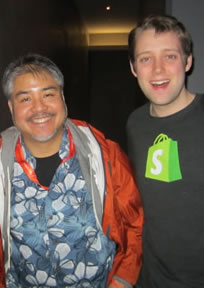 My friend Mark Hayes, one of the marketing guys at my former workplace, Shopify, is looking for a Toronto-based social media and community manager. Shopify, in case you’re not familiar with the company, is a wildly successful ecommerce platform that’s moved over a billion — that’s right, billion with a b — dollars worth of goods since its inception about five years ago. It’s one of Canada’s biggest startup success, and a great place to work.
My friend Mark Hayes, one of the marketing guys at my former workplace, Shopify, is looking for a Toronto-based social media and community manager. Shopify, in case you’re not familiar with the company, is a wildly successful ecommerce platform that’s moved over a billion — that’s right, billion with a b — dollars worth of goods since its inception about five years ago. It’s one of Canada’s biggest startup success, and a great place to work.
Hey r/Toronto:
My name is Mark and I work at an ecommerce platform called Shopify. This week, I plan on hiring someone from r/Toronto to be our social media and community manager. If you’re really, really, ridiculously good at social media and want to work at an awesome company – read on.
Why I’m on r/Toronto:
I need to hire a social media and community manager in Toronto. Last time I hired someone (a marketing copywriter), I made it a public job posting. I received over 800 applications… going through them all was awful.
This time, I’m not making a public job posting. I plan on finding our new social media manager this week on r/Toronto. Yes, I have that much confidence in the power of Reddit. :-)
I’m working out of Shopify’s Toronto office until Friday and would love to grab coffee with Toronto’s best social media people. Here’s a bit about working at Shopify:
- Exciting challenges to face, and problems to solve every day!
- Competitive salary
- Shares in the company
- Flexible work hours
- Free house cleaning service
- Free gym membership
- Office 5 min from Union Station
- More here.
About Shopify:
- We’re an ecommerce platform with over 40,000 online stores around the world.
- Profit Magazine called us the smartest company in Canada.
- Fast Company named us one of the world’s top 50 most innovative companies.
How to get hired: Shoot me an email, mark.hayes@shopify.com with a short intro and links to a couple of your social media platforms. Also please include a link to your LinkedIn, but if you don’t have one – don’t worry. No resume, cover letter or any of that stuff. I’ll respond to anyone who I would like to get to know a bit better and we’ll grab a coffee sometime this week!
Also, of course feel free to chat w/ me in the comments here. Thanks so much r/Toronto!
Edit: It occurred to me that those who want this job may downvote to decrease visibility of this post and increase their chances. Please don’t. :-) I hope to have as many coffees as possible this week, so chances are I’ll get to meet most who apply!
If you’re in the social media / community management line of work and are looking for a great gig, this is it! Be sure to drop Mark a line and tell him Joey sent you!
This article also appears in The Adventures of Accordion Guy in the 21st Century.

During those rare lunches when I eat alone, this bowl/smartphone cradle might come in handy.
This article also appears in Mobilize!: The CTS Mobile Tech Blog.